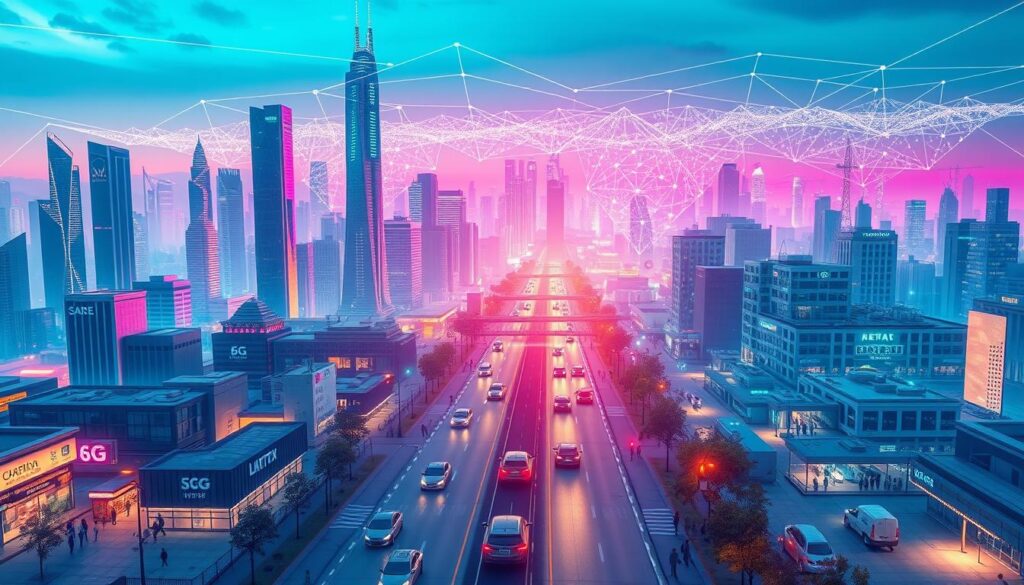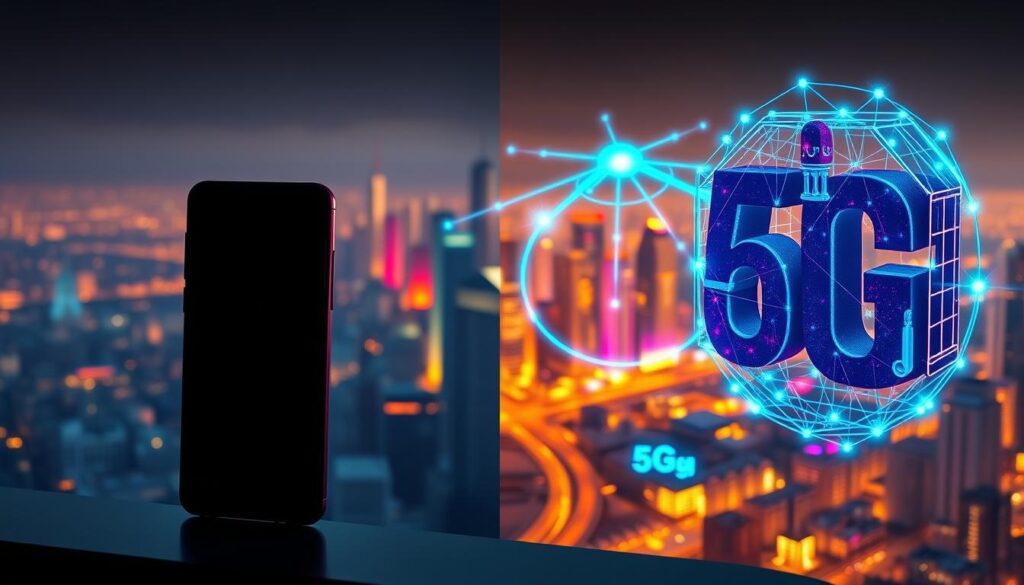
The future of connectivity is evolving faster than ever. With advancements in technology, the next generation of wireless communication promises unprecedented speed and reliability. Imagine downloading a full-length movie in milliseconds or experiencing near-instant response times for critical applications.
By leveraging ultra-high frequencies, networks will achieve speeds up to 100 times faster than current standards. This leap forward opens doors for innovations like AI-driven traffic systems and remote medical procedures. Governments and tech giants are already investing heavily to make this vision a reality.
However, challenges remain. Signal limitations and infrastructure costs must be addressed to ensure seamless integration. Despite these hurdles, the potential to revolutionize urban living is undeniable.
Key Takeaways
- Next-gen wireless technology will redefine connectivity standards.
- Ultra-fast speeds enable groundbreaking real-world applications.
- Global investments are accelerating research and development.
- Signal propagation and infrastructure remain key challenges.
- Urban environments stand to benefit most from these advancements.
Introduction: The Dawn of 6G Technology
We stand at the brink of a connectivity revolution unlike anything before. While 5G laid the groundwork, the next generation of wireless communication promises a true paradigm shift. It’s not just about speed—it’s about merging computing, sensing, and AI to create immersive experiences like holographic telepresence.
Early research shows potential applications that sound like science fiction. Brain-computer interfaces could let us control devices with thoughts. Industrial IoT systems might predict equipment failures before they happen. Companies like SoftBank are already testing terahertz frequencies for connected vehicles, proving this isn’t just theoretical.
The table below highlights how 6G expands on 5G’s capabilities:
| Feature | 5G | 6G |
|---|---|---|
| Peak Speed | 20 Gbps | 1 Tbps |
| Latency | 1 ms | 0.1 ms |
| AI Integration | Limited | End-to-end |
This leap forward relies on blending quantum communications with advanced data processing. Imagine smart cities where traffic lights adapt in real-time or hospitals perform remote surgeries with zero lag. The future isn’t just connected—it’s intelligently intertwined.
Governments and tech giants are racing to lead this innovation. The U.S., China, and the EU have all launched major initiatives. Whoever cracks the code first will shape the next decade of digital infrastructure.
The Evolution from 5G to 6G: What’s Changing?
The shift from 5G to the next generation of wireless technology isn’t just incremental—it’s revolutionary. While 5G introduced faster speeds and lower latency, the upcoming advancements redefine what’s possible. From holographic calls to AI-driven networks, the leap is monumental.

Key Differences Between 5G and 6G
5G relies on millimeter-wave (mmWave) frequency bands, but 6G pushes into the terahertz spectrum. This unlocks speeds up to 1 Tbps—100 times faster than 5G’s peak. Latency drops to 1 microsecond, enabling real-time applications like remote surgery and autonomous vehicle coordination.
Here’s a quick comparison:
| Feature | 5G | 6G |
|---|---|---|
| Speed | 10 Gbps | 1 Tbps |
| Latency | 1 ms | 0.001 ms |
| Spectrum | mmWave | Terahertz |
The Role of Terahertz Frequencies in 6G
Terahertz waves are the backbone of next-gen networks. They offer massive bandwidth but face challenges like signal loss. Innovations like reconfigurable intelligent surfaces (RIS) and beamforming help overcome these hurdles.
Companies like SoftBank are already testing terahertz for outdoor use. Their 140-meter trial proves feasibility for vehicular networks. Yet, hardware like graphene modulators and plasmonic antennas must evolve to support these frequency bands.
Key advantages include:
- Ultra-high capacity for holographic communication
- AI-driven network optimization
- Seamless IoT integration
Upgrading infrastructure will be critical. Cities must adapt to harness this potential fully.
Understanding Terahertz Frequencies: The Backbone of 6G
The next leap in wireless technology hinges on an invisible force. Terahertz (THz) bands occupy the electromagnetic spectrum between microwaves and infrared light. Operating at 100 GHz to 3 THz, these frequencies deliver fiber-like speeds without physical cables.
The Science Behind Ultra-High Speed Waves
THz waves sit at the frontier of usable signals. Their range is limited by atmospheric absorption, especially in humid conditions.
“THz communication achieves 1 Tbps in lab conditions—enough to download 50 HD movies per second.”
Key characteristics include:
- Wavelengths between 1mm to 0.1mm
- Bandwidth capacities exceeding 100 GHz
- Penetration through non-conductive materials
Why Cities Need This Bandwidth
Urban areas demand massive data transmission capacity. THz bands enable:
- Real-time 8K video streaming for surveillance
- Instant cloud backups for smart infrastructure
- Precision industrial automation
Researchers combat propagation limits with:
- AI-powered signal routing
- Reconfigurable intelligent surfaces
- Beamforming antennas
Early adopters include data centers using THz for rack-to-rack links. The technology could soon power factory robots communicating at microsecond latency.
6G in 2025: How Terahertz Frequencies Will Transform Smart Cities
Urban landscapes are on the verge of a digital revolution, powered by unprecedented connectivity. With ultra-fast networks, cities will harness real-time data to optimize everything from traffic flow to energy distribution. This shift isn’t just about speed—it’s about creating seamless, intelligent ecosystems.
Real-Time Data for Urban Management
Advanced sensors embedded across cities will monitor air quality, congestion, and power usage. AI analyzes this data instantly, adjusting streetlights to reduce jams or rerouting buses based on passenger density. Glasgow University’s DMA antenna cuts IoT power use by 88%, enabling scalable deployments.

Emergency responders benefit too. Real-time updates from systems like ISAC (Integrated Sensing and Communication) provide live hazard maps during crises. Firefighters could see building layouts or gas leaks before arriving.
Enhanced IoT Connectivity in Smart Cities
The next wave of IoT devices will connect billions of gadgets with zero lag. From smart bins signaling pickup times to grids balancing renewable energy, latency-free communication is key. Compare current and future capabilities:
| Feature | 5G IoT | 6G IoT |
|---|---|---|
| Devices per km² | 1 million | 10 million+ |
| Response Time | 5 ms | 0.1 ms |
| Energy Efficiency | Moderate | Ultra-low |
Such advancements make smart cities more adaptive. Waste trucks follow AI-predicted routes, and buildings adjust HVAC systems using weather forecasts. The future urban experience will be effortless, efficient, and interconnected.
Applications of 6G in Smart City Infrastructure
Smart cities are about to get a major upgrade through advanced connectivity. Next-gen networks will power innovations that make urban spaces safer, greener, and more efficient. From self-adjusting traffic lights to disaster-ready communication systems, the applications are limitless.
Smart Traffic Management Systems
Congestion could become a relic of the past. Vehicles will communicate with traffic lights, road sensors, and each other via V2X (vehicle-to-everything) networks. Real-time data will optimize signal timing, reducing idle time by up to 30%.
Autonomous cars will use these networks for collision avoidance. Trials in Tokyo show a 90% drop in near-miss incidents with 6G-enabled AI predictions.
| Feature | Current Systems | 6G-Enhanced |
|---|---|---|
| Response Time | 2 seconds | 0.1 milliseconds |
| Data Inputs | Traffic cameras | IoT sensors + drones |
Energy-Efficient Grids and Sustainability
Smart grids will balance renewable energy sources dynamically. AI analyzes weather patterns and usage data to distribute solar or wind power where it’s needed most. Devices like smart meters will sync seamlessly, cutting energy waste by 25%.
Key benefits include:
- Real-time adjustments to prevent blackouts
- Lower carbon footprints for urban areas
- Scalable integration of EV charging stations
Public Safety and Emergency Response
When disasters strike, security systems will react instantly. HAPS (High-Altitude Platform Stations) drones restore connectivity in outage zones, enabling rescue teams to coordinate via holographic maps. Wearable tech monitors first responders’ vitals, alerting command centers to overheating or fatigue.
“6G’s microsecond latency saves lives by delivering critical data faster than human reflexes.”
Cities like Miami are piloting these systems for hurricane season, proving their potential to transform crisis management.
The Role of AI in 6G Networks
Artificial intelligence is the silent powerhouse behind next-gen connectivity. It doesn’t just support networks—it transforms them into self-healing, adaptive systems. By analyzing vast amounts of data, AI optimizes performance in ways humans alone cannot achieve.

AI-Driven Network Optimization
Imagine a network that predicts congestion before it happens. Machine learning models analyze traffic patterns, rerouting signals dynamically to maintain peak performance. Glasgow’s DMA antenna trials show AI-powered beamforming cuts energy use by 88% while boosting signal strength.
Key innovations include:
- Real-time resource allocation for crowded areas
- Self-adjusting frequencies to avoid interference
- Predictive maintenance for infrastructure
“AI reduces network downtime by 70% through anomaly detection.”
Predictive Analytics for Urban Planning
Cities grow smarter when AI processes historical and real-time data. Urban planners use these insights to simulate zoning changes, transit expansions, and housing needs. Singapore’s virtual city model predicts population shifts with 95% accuracy.
Ethical considerations remain crucial. While AI-enhanced surveillance improves public safety, strict governance prevents misuse. Transparency in research and deployment ensures these tools benefit everyone equally.
The fusion of AI and connectivity drives innovation at every level. From optimizing energy grids to streamlining emergency responses, intelligent networks will redefine urban living.
Challenges in Implementing 6G Technology
Deploying next-gen networks presents unique obstacles that demand innovative solutions. While ultra-fast speeds and low latency promise to redefine connectivity, real-world adoption faces technical and financial barriers. Cities must navigate these hurdles to unlock the full potential of advanced networks.
Technical Hurdles with High-Frequency Bands
High-frequency signals struggle with physical obstructions. Walls, foliage, and even rain can disrupt transmission. Unlike lower bands, these waves have limited range, requiring dense antenna deployments every 100–200 meters.
Key limitations include:
- Signal absorption by atmospheric moisture
- Line-of-sight dependency for reliable connectivity
- Interference from existing wireless systems
“THz networks need 10x more base stations than 5G for equivalent coverage.”
Infrastructure and Cost Considerations
Building a robust network demands massive investment. Urban areas require:
- Citywide small-cell installations
- Fiber-optic backhaul for data transport
- Stratospheric drones (HAPS) for dead zones ($2M–$5M per unit)
Nationwide rollout estimates range from $200B to $500B in the U.S. alone. Workforce shortages in RF engineering and quantum computing further delay progress. Public-private partnerships could accelerate deployment while sharing cost burdens.
Despite these challenges, pilot projects in Tokyo and Oslo prove solutions exist. With strategic planning, cities can turn barriers into breakthroughs.
Security and Privacy in 6G-Powered Smart Cities
As cities embrace ultra-connected infrastructure, safeguarding digital ecosystems becomes critical. The shift to advanced wireless systems introduces both opportunities and vulnerabilities. Protecting sensitive information while maintaining seamless operations requires innovative approaches.
Emerging Cybersecurity Challenges
Massive IoT deployments create attractive targets for malicious actors. Botnets could potentially hijack thousands of smart devices, disrupting power grids or transportation networks. Recent simulations show a single compromised traffic light can cascade into citywide chaos.
Key threats include:
- Distributed denial-of-service (DDoS) attacks on municipal systems
- AI-powered malware adapting to defense mechanisms
- Supply chain vulnerabilities in network hardware
“Quantum Key Distribution (QKD) creates theoretically unbreakable encryption using photon polarization.”
Protecting Citizen Data in Smart Environments
Urban sensors collect vast amounts of personal information, from facial recognition to movement patterns. Ensuring data privacy requires:
- GDPR-compliant anonymization techniques for biometric data
- Blockchain-based audit trails for transparency
- Post-quantum cryptographic standards in all hardware
SoftBank’s successful QKD trials demonstrate how quantum-resistant protocols can secure core network links. Their system maintains security even against future quantum computers.
Balancing innovation with protection remains essential. Cities must implement robust frameworks that inspire public trust while enabling technological progress.
The Global Race for 6G Dominance
Nations and corporations are locked in a high-stakes competition to lead the next wireless revolution. This isn’t just about faster phones—it’s about controlling the infrastructure that will power entire economies. The winners will shape global tech standards for decades to come.
Key Players and Investments
China has taken an aggressive stance, pouring $1.4 billion into state-backed research. Their approach focuses on centralized development through institutions like the IMT-2030 Promotion Group. In contrast, the U.S. relies on private sector giants—Qualcomm and Intel lead consortia with DARPA funding.
Europe’s strategy blends both models. The EU’s Hexa-X project unites Nokia, Ericsson, and academic partners. Their focus? Developing reconfigurable intelligent surfaces (RIS) that boost terahertz signal range by 300%.
| Region | Investment | Key Innovation |
|---|---|---|
| China | $1.4B state fund | Integrated sensing networks |
| USA | $600M private R&D | AI-optimized frequency bands |
| EU | $750M joint fund | THz repeater patents |
Geopolitical Implications
Export controls reveal the battle’s intensity. The U.S. restricted gallium nitride shipments—a critical material for terahertz chips. Meanwhile, Huawei holds 15% of foundational patents, prompting Western alliances to develop alternative technologies.
India’s $450M Bharat 6G Alliance targets rural connectivity gaps. Their open-source approach could democratize access but risks creating fragmented standards. As SoftBank’s CEO warns:
“Without global cooperation, we’ll face a Tower of Babel in wireless innovation.”
Key flashpoints to watch:
- Patent wars over beamforming technologies
- 5G infrastructure becoming obsolete
- Supply chain battles for rare earth minerals
The race isn’t just about speed—it’s about who controls the nervous system of tomorrow’s digital business ecosystems. Early leads suggest a multipolar future with competing technological blocs.
Preparing for a 6G Future: What Cities Need to Do
Municipal leaders face a pivotal moment in technological history. Upgrading urban infrastructure requires more than hardware—it demands visionary policies and unprecedented collaboration. The FCC’s spectrum roadmap suggests allocating THz bands by 2024, giving cities limited time to prepare.

Building Effective Policy Frameworks
Los Angeles offers a blueprint with its 6G-ready streetlight program. By embedding small cells in municipal assets, they’re creating dual-purpose systems. Other cities should consider:
- Regulatory sandboxes for testing drone-based networks
- Tax credits for carriers deploying THz antennas
- Workforce programs training technicians in AI ethics
“Spectrum-sharing models could save cities $3B annually while accelerating deployment.”
Powering Progress Through Partnerships
Private sector expertise meets public oversight in successful collaborations. Chicago’s pilot with telecom giants demonstrates how shared business models fund infrastructure. Key elements include:
- Clear revenue-sharing agreements
- Standardized equipment interoperability
- Community benefit clauses
High-altitude platform stations (HAPS) highlight global coordination needs. These stratospheric drones require international airspace agreements—a challenge the U.S. and EU are currently negotiating.
Energy-efficient networks present another opportunity. Smart grids using 6G connectivity could reduce municipal power costs by 18%. Pilot programs in Austin show how real-time energy data optimizes distribution.
The transition won’t happen overnight, but strategic planning today ensures cities reap tomorrow’s benefits.
Conclusion: The Future of Smart Cities with 6G
A new era of urban intelligence is dawning, driven by ultra-fast networks. Real-time data ecosystems will thrive, with 6G enabling instant responses from traffic grids to emergency services. By 2030, autonomous infrastructure could become the norm, not the exception.
Ethical governance must guide this innovation. Balancing AI-driven efficiency with privacy protections ensures smart cities serve everyone. Inclusive access prevents a digital divide, bridging gaps in education and healthcare.
Ultimately, connectivity will power climate-resilient urban hubs. From energy-efficient grids to disaster-ready systems, the future of cities is sustainable—and smarter than ever.
